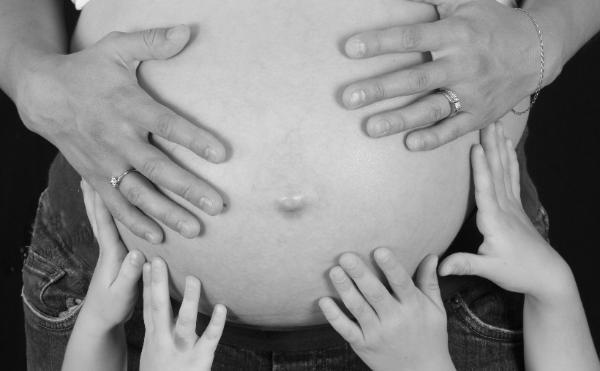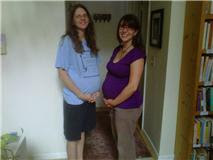There's such a wide range of normal! I wish more mothers--and America in general--understood and accepted this. People seem to have a very narrow idea of what is normal, but people come in all shapes, heights, builds, weights, and more--why wouldn't there be such a wide variation in healthy pregnancies as well?
So long as both mom and baby are faring well, there's nothing wrong with a mom carrying so "small" that she's barely showing, nor anything wrong with a momma who gets asked if she's having twins every time she leaves the house (even if she's carrying a singleton). Let's don't undermine another mother's confidence by questioning whether her size/appearance is too big or too little (unless you happen to be her care provider).
Take my friend Christy and me, for example. In this pic from this weekend, Christy is nearly 37 weeks along with her 4th baby (that is to say, she could go into labor any time between now and a month from now), and I'm 23 weeks along with my 5th. We're both healthy and fine.
My friend Trebor is due with her 5th baby around 2 weeks after I'm due. Just wait until later in our pregnancies and the difference will be photo-worthy, I promise.
 |
| Sarah 22 weeks, Trebor 20 weeks |
In summary, here is a list of things nobody should ever say to a pregnant woman:
If you think mom looks "too big":
- "Wow, you're huge!" (Does this sound like it could EVER be a good idea to say to a woman?)
- "You look like you're ready to pop!"
- "Are you sure there's only one in there?/Are you sure it's not twins/triplets?"
- "I hope you don't go into labor right here and now!"
- "Are you sure you're not due for 2 more months?" along with
- "There's no way you're going to make it to your due date, since you're so big now." (The mom might go early, on due date, or 2 weeks late. How she carries/looks is not a predictor or indicator of how long baby needs to gestate. You'll either have her worried that she'll end up with a premie or disappointed if she gets her hopes up that she won't go all the way to her due date but then goes "late.")
- "You had better not eat/drink that!" (This is sometimes said to a mom with a dessert or coffee in her hand. The observer has no idea what the rest of her diet looks like, not that it's any of their business.)
- "Your baby is going to be HUGE!!!" (Even if the mom has successfully and healthfully delivered 10 and 11 pounders already, this is NOT what a mom wants to hear. It's not encouraging.)
- "How much weight have you gained?" (This is NEVER a good idea to ask a woman, unless you are her care provider.)
If you think mom looks "too small":
- "You're so tiny you don't even look pregnant!" (This one can be especially upsetting for a mother who has lost one or more babies in the past, who might be concerned whether this baby will grow to full term healthfully.)
- "Are you sure you're due that soon?" (No mom wants for people to imply that she needs several additional weeks/months to gestate, beyond the biological norm.)
- "You'll probably have a teeny tiny baby." (No mom wants for anyone to imply that she'll probably end up with a premie or sick baby.)
- "You should eat more." (No mom wants for random strangers to judge her diet. She might be eating the most healthful diet possible, and this is just the shape her body takes. Or she might be eating only junk. Either way, it's nobody's business but hers and her care provider's.)
- "How much weight have you gained?" (See above.)
Here are a few starters for acceptable things to say to a random pregnant woman:
- "You look great!"
- "How do you feel?"
- "Congratulations!"
Mommas, are/did you carry "large", "small," or in between? Did you receive any comments from people who thought you were carrying "too large" or "too small"? What affect did that have, if any? What positive things did people say about your pregnant appearance that encouraged you (or what do you wish had been said)?
**** UPDATE****
October 11, 2011
Remember how I told you that belly comparisons with my friend Trebor would be interesting over time? She's due two weeks behind me, with her 5th pregnancy this far along as well. She and our friend Eileen (3rd baby) share the same due date, and we three all have the same midwife. (This should be an interesting competition for who gets our midwife, and when. We're hoping we don't go into labor at the same time!)
 |
| L-R: me (Sarah) at 29 weeks; Trebor and Eileen at 27 weeks |
************** UPDATE Nov. 6, 2011 *************
 |
| Sarah at 33 weeks, Trebor at 31 weeks |
 |
| Sarah at 33 weeks, Trebor at 31 weeks. |
Can I say "I told you so" yet?
************ UPDATE December 1, 2011 *************
Same 3 mommies, same 3 bellies, a bit closer to due dates.
I'm on the far left. I'm 36.5 weeks along. Trebor and Eileen are both 34 weeks along. Yes, I'm aware that my belly is roughly 1.5 times the size of Eileen's and twice the size of Trebor's. You may also notice that Trebor and Eileen are a good 4 inches taller than me (I was wearing wedge heels; Trebor and Eileen were in flats). When you're as short as I am, with a short torso, there's nowhere for baby to go but *out*.
************ UPDATE December 1, 2011 *************
Same 3 mommies, same 3 bellies, a bit closer to due dates.
I'm on the far left. I'm 36.5 weeks along. Trebor and Eileen are both 34 weeks along. Yes, I'm aware that my belly is roughly 1.5 times the size of Eileen's and twice the size of Trebor's. You may also notice that Trebor and Eileen are a good 4 inches taller than me (I was wearing wedge heels; Trebor and Eileen were in flats). When you're as short as I am, with a short torso, there's nowhere for baby to go but *out*.






